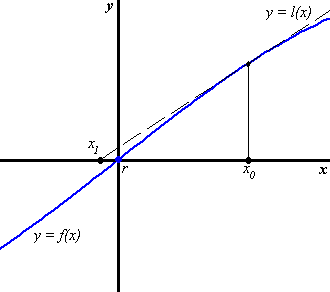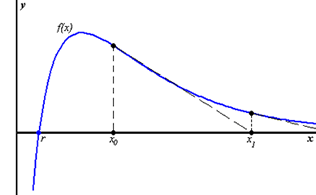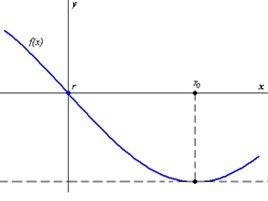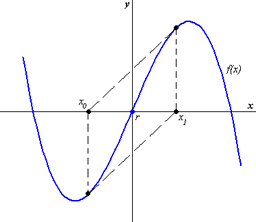Newton's Method
Learning Project Summary
- Project Code: Newton's Method
- School: Computer Science
- Department: Scientific Computing
Content Summary
This learning project offers learning activities to Newton's Method. In this course, students will learn how to solve problems of the type using the Newton’s Method, also called the Newton-Raphson iteration.
using the Newton’s Method, also called the Newton-Raphson iteration.
Derivation of the Newton's Method
In Newton’s method, we must first assume that the function is differentiable, i.e. that function has a definite slope at each point. Hence at any point
has a definite slope at each point. Hence at any point , we can calculate the tangent
, we can calculate the tangent , which is a fairly good approximation to the curve at that point. Alternatively, we can see that linear function
, which is a fairly good approximation to the curve at that point. Alternatively, we can see that linear function

is quite close to function near point
near point  , and at
, and at  , the functions
, the functions  and
and give the same value. Hence, we take it that the solution to the problem
give the same value. Hence, we take it that the solution to the problem  will give a fairly good approximation to the problem
will give a fairly good approximation to the problem .
.

The zero of  can be easily found:
can be easily found:
This can be done repeatedly to produce points with the following equation:
An alternative way of viewing Newton’s method is as follows: we let  be our approximation to the problem
be our approximation to the problem  , then we try to solve for the correction h such that
, then we try to solve for the correction h such that
If  is well-behaved function, we can then write the Taylor series at
is well-behaved function, we can then write the Taylor series at  as
as
By dropping all but the first two terms of the series, we can achieve an approximation of h through the equation
Solving for h, we then achieve our next approximation to the root of  with the equation
with the equation
Repeating this process results in the recursive definition of Newton’s Method
The success of Newton’s method depends on whether the following equation holds:
 where r is the root of
where r is the root of  .
.
Code
The following is an example of a function that can be written using MATLAB to perform Newton's Method on any given mathematical function  .
.
function x = Newton(f, fp, x, nmax, e) % f is an inline function which we apply Newton's method on % fp is an inline function that is the derivative of function f % x is the initial guess of the root % nmax is the total number of iterations done % e is the error used to control convergence fprintf('x(0) = %10g \n', x) for n = 1:nmax d = f(x)/fp(x); x = x - d; fprintf('x(%i) = %10g \n', n, x) if abs(d) < e fprintf('Converged! \n') return end end
Example
We try to locate the root of the equation  with initial starting point
with initial starting point  = 3. Note also that the derivative of the above function is
= 3. Note also that the derivative of the above function is 
Then we do the following:
declare our function f f = inline('x^3 - 2*x^2 + x - 3'); % declare the derivative of function f fp = inline('3*x^2 - 4*x + 1'); % declare total number of iterations to be undertaken nmax = 10; % declare value of initial starting point x = 3.0; % declare amount of error allowed e = 1.0e-15; % carry out iteration using function above x = Newton(f,fp,x,nmax,e) % results are as follows: x(0) = 3 x(1) = 2.4375 x(2) = 2.21303 x(3) = 2.17555 x(4) = 2.17456 x(5) = 2.17456 x(6) = 2.17456 x(7) = 2.17456 Converged! x = 2.174559410292980
Problems and Restrictions of Newton's Method
Firstly, and most obviously, Newton's Method can only be applied with functions that are differentiable. This can be seen straight from the formula, where f’(x) is a necessary part of the iterative function.
Secondly, the starting point must be chosen carefully, and it is best chosen with an approximate idea of the graph of the function in mind. If chosen wrongly, one of the following three situations could happen:

- Runaway: In which Newton’s Method leads away from the root instead of towards the root; the solution diverges rather than converges.
- Flat Spot: In which the derivative of the graph at the starting point is 0, and thus the next iterative point occurs at infinity and cannot be used.
- Cycle: In which the solutions cycle between two points, and never converges to the root.


Convergence
Newton's method is said to converge quadratically to the root r, if r is a simple root, i.e.  . This means that the errors obey the inequality
. This means that the errors obey the inequality .
.
Using the Taylor Series, we see that there exists some point  between
between  and
and  such that
such that
Dividing the last equation throughout by  , we get
, we get
Substituting the equation used in Newton's Method, we get
Thus
Exercises
- Locate the root of
 nearest
nearest  using Newton's method.
using Newton's method. - Two of the four zeros of
 are positive. Find them by Newton's method, correct to two significant figures.
are positive. Find them by Newton's method, correct to two significant figures.
References
[1] Cheney, Ward and Kincaid, David. Numerical Mathematics and Computing. 6th Edition. United States: Thomson Brooks/Cole, 2008.
Active Participants
Active participants in this Learning Group
- Esther










